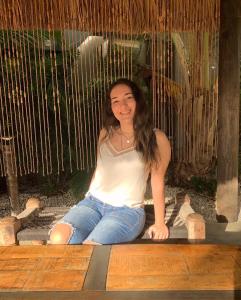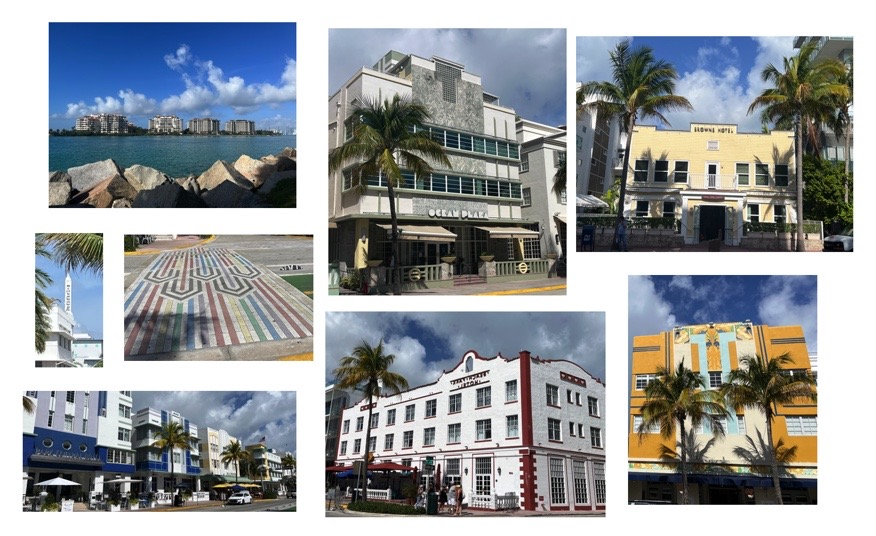
Images taken by Hannah Strong (CC by 4.0)
Leah Daire is a Biology undergraduate student at Florida International University (FIU). Once she graduates, she plans to attend medical school. She is involved in the Peer Led Team Learning (PLTL) program at FIU and the organization Panthers Uniting in Support of Health (P.U.S.H.). She has a large family who come from Cuba and Lebanon, however, she was raised primarily under the Cuban culture. She loves reading, jogging, bike riding, and pets.
……………………………………………………….
Deering as Text

Images taken by Leah Daire (CC by 4.0)
“Geographical Ancestors”
By Leah Daire of FIU at the Deering Estate on January 28th, 2022.
Miami is known as a mixing pot of cultures. People living here hail from a variety of countries all around the world. And while a diverse community, the majority of the population is of Hispanic/Latin decent. In 2021, demographics showed that 71.51% of the Miami-Dade County population was Hispanic/Latino1. The people who belong to this category, myself included, are very proud of their culture and where their family comes from. However, this is only one side of the coin.
Every single person living in Miami has another set of unspoken ancestors. This culture less discussed is that of our geographical ancestors. The first people to inhabit Miami were not the Spaniards who stumbled upon this land from Europe, but the Natives who lived here for generations before. The Tequesta lived in the land which now holds the Deering Estate. They lived alongside the Biscayne Bay, which was a source of life for them. They used shell tools to hunt fish, etc. They can be seen next to the Tequesta Midden on the lands of the Deering Estate today. The Tequesta Cutler Burial Mound can also be found here. It is one of the two unearthed Tequesta Burial sites. The bones are laid to rest in a circular pattern around a grand oak tree. The Tequesta are now an extinct people with very little known of them, such as their image and language.
Much of what is known of the Tequesta is in the form of accounts from Spaniard colonialists who lived in Florida. The Tequesta were related to the Caloosa people, who inhabited a major part of Florida. They had a very positive relationship with the Spaniards; such so that when the British took control of Florida, various Tequesta families migrated to Cuba. The Tequesta were known to hunt a variety of marine organism and eat roots. They did not practice much agriculture. Their religion focused on nature, especially revering the sun and the moon. The Tequesta took part in a variety of rituals, many of which included dancing in them. They had a few sacrificial ceremonies as well, however, they were not very violent people in general. The Tequesta held a special regard for the dead and their bones2. This makes having visited the burial ground in Deering Estate that much more sacred.
References
1Miami Matters. (2021, January). 2021 Demographics. Miami Matters. https://www.miamidadematters.org/demographicdata
2McNicoll, R. E. (1941). The Caloosa Village Tequesta. University of Miami
……………………………………………………….
Vizcaya as Text

Images taken by Leah Daire (CC by 4.0)
“The Combination of Two Cultures”
By Leah Daire of FIU at Vizcaya Museum & Gardens on February 18th, 2022.
In 1492, after the Reconquista in Spain, most Muslims were removed from the country except for skilled artisans, astrologists, writers etc. These artisans were allowed by Spanish nobles to continue creating their invaluable works. Thus, the style of Mudejar was created. Mudejar art is a mix between Christianity and Islam. Some key elements of Mudejar art is geometric aspects, calligraphy, and intricate tile patterns. In Aragon, many building have been dubbed UNESCO World Heritage sites. Many of these buildings were originally Moorish buildings which had Christian elements added upon after the Reconquista.
One such artist created the Admiral Carpet found at Vizcaya. It can be seen in the living room, which is one of the most prominent spaces in the locale; it is where Pope John Paul II and President Ronald Reagan sat down. The Admiral Carpet was created in the 1450’s for King Ferdinand’s grandfather. The major decorative elements are two coat of arms and the words There is No God but Allah in Arabic. The coat of arms can be seen in the center of the carpet to highlight the Spanish nobility. The carpet, however, is designed in a largely Islamic style.
……………………………………………………….
Miami as Text

Images taken by Leah Daire (CC by 4.0)
“An inclusive Miami”
By Leah Daire of FIU at Downtown Miami on March 11th, 2022.
Julia Tuttle helped make Miami into the city is today. In the winter of 1894-95, she convinced Henry Flagler to expand railways down South and further gave him about half of her land to farm citrus. She sent him a box of freshly grown oranges, a rarity, as most oranges had frozen in that winter. Seeing the profit in the land down South, Henry Flagler expanded his railways to Miami.
Julia Tuttle lived in Cleveland, Ohio. She came to purchase her property after paying a visit to her parents. Just as many tourists who come down to Miami, Julia Tuttle fell in love. She bought the land upon the death of her husband and her father, and set out to develop it. It was her dream to see it grow into a larger settlement; however, she died two years after Henry Flagler brought the railroad down.
It is great to see how a woman set about creating one of America’s biggest cities. However, this step is also foreshadowed by the future segregation that would be put in place by Henry Flagler. Those who built Miami, the black Bahamians, were unable to there, but instead were made to live in Colortown (now Overtown). The establishment of Miami takes both a step forward and back in terms of inclusivity. It is our job to recognize these two parallels and to educate others.
……………………………………………………….
SoBe as Text

Images taken by Leah Daire (CC by 4.0)
“new construction”
By Leah Daire of FIU at South Beach on April 1st, 2022.
As I write this, I am sitting outside in CocoWalk. Across the street there is a newly constructed building that has Miami written all over it. Included in the design are porthole windows, curved edges, and bright colors. With just one look, it is unmistakable that the building is built to resemble a ship sailing through the ocean. This building was created in the Miami Modern (MiMo) architecture style. MiMo began in the 1950’s and has since spread throughout Miami. There can, at times, be a thin line between MiMo and Art Deco, as the former arose from the later, but there are a few key elements that distinguish them, primarily the more modern aesthetic and asymmetry.
Many new buildings are built in the MiMo style in order to attract occupants. Their unique look is appealing to many, especially those who move to Miami and are not accustomed to the regional style. In Biscayne Boulevard, there is a new area dubbed the Miami Modern District, in which restaurants and hotels are built in the MiMo style. This area is popular on the social media platform, Instagram, as tourists and residents alike visit to take pictures to gain popularity online.
……………………………………………………….

Help me fund my study abroad in Spain
leahhdaire@att.net
$1.00